Last Monday and Tuesday, Annette and I had work-related meetings in South Tyrol (northern Italy). We visited several production facilities owned by the Rubner Group, a holding company that includes manufacturers of glulam beams, wood panels, engineered timbers, and pre-fabricated houses. Since it’s January and the Alps are between Germany and Italy, we decided to spend the weekend near Innsbruck, Austria, on our way south.
For years Annette has been interested in backcountry skiing. She got a taste of it last year while visiting our friends Julie, Adam and Christina in Idaho, but she has always wanted to ski backcountry in the Alps. Last weekend we were able to try it.
We stayed in Praxmar, a collection of Alpine buildings at the end of a box canyon. We arrived mid-afternoon on Saturday, and the sun was already starting to dip behind the massive snow-capped mountains that surround the valley on three sides. After dropping off our bags, Annette and I headed for the garage where the sleds are stored. Praxmar has a rodelbahn, or sledding track, and Annette was determined for us to try it out.
I have seen rodel-type sleds throughout Germany and Austria, but not in America. They are typically built of ash, with woven “seats” and metal runners. They go fast on packed snow. One sits on the sled facing forward, using the feet to steer and brake. We grabbed a double sled and headed toward the rodelbahn. Annette’s excitement was unrestrained and infectious.
The track itself was wide and winding, the snow well-packed. We were not sure how long the hike up would take; we found out later that it was 5 kilometers in length. The guest house where we were staying is at 1700 meters (about 5600 feet), and it wasn’t long before we were sucking for air. Our breaks became more frequent. We began to wonder whether we would reach the top of the track — marked by a hut — before dark. And would the hut serve Glüwein and beer? Annette pointed out that sledding down in the dark would be an adventure. I agreed, but was also noticing drop-offs at the edge of the track that looked steep and long. Why doesn’t one find rodelbahns like this in the US? Perhaps because Americans tend to be litigious. Lower down on the trail we had passed a small shrine to the Virgin Mary, and on a promontory in the distance I could see a white cross. I wondered whether these markers serve the same function as the white crosses that one occasionally sees road-side in New England.
And still higher we went. There were numerous ski tracks crossing the rodelbahn, and several times we were passed by skiers heading down on the track itself. The skiers had hiked up — to the summit of the mountain, or just to the top of the rodelbahn? — and then presumably decided to ski down on the rodelbahn rather than tackle what looked to me like challenging glade skiing.
Just as dusk was starting to fall, we arrived at the hut. It was closed. In fact, it looked more like a small storage building than a place where one might find comfort and sustenance.
“Do you want to be in front or in back?” asked Annette, chipper now that our descent was imminent. I wasn’t sure.
“Normally the heavier person is in back, but the person behind also has to steer and brake.” I told her I would give it a shot.
“Push me, then jump on!” I did, and we were gaining momentum down the track. It took me a few moments to figure out the steering: put pressure down — but not too much — with the left foot to veer left, and with the right foot to turn right. Both feet can be used to brake. We sped downward, fish-tailing back and forth, frequently going what I thought was too fast and too close to the edge.
“How about you let me steer?” Annette called back to me. I agreed.
That seemed to work better, although when we would start to get too close to the downhill edge of the track, I would instinctively stick out my foot on that side. This was a mistake, because the sled would then veer closer to the edge. Eventually our motion smoothed out, and we were even able to round a few of the hairpin turns without completely losing momentum or careening into a snowbank. We made it to the bottom in one piece.
Back at the guest house, Annette asked if I wanted to use the sauna. Although I am not a big fan of saunas (call me a Yankee, not a prude), I thought it might be nice to take the chill out of my bones. The sauna turned out to be a popular place. Several men and women were lying naked on lounge chairs outside the sauna, waiting for space to open up within. When someone emerged, one of the people waiting would go in. Annette was able to get into the sauna a few minutes after we arrived. I wasn’t confident or assertive enough, or maybe I really didn’t want to go into the sauna with a group of naked sweaty strangers. I resisted the urge to head back to our room. The sauna door opened again. I rose toward it, as did the guy lounging next to me. We politely offered the space to each other, and then I quickly accepted, wanting to get the sauna experience over with. The sauna was about six feet by six feet, with upper and lower L-shaped benches. I squeezed into the one open spot on the lower bench, and tried to relax into the heat. I think it was good for me — the heat, and the experience. Later on in the dining room, I found myself wondering whether I had been sitting in the sauna with the people dining at the adjacent table. They looked different with clothes on.
“Did you notice how fit everyone seemed in the sauna?” asked Annette. I had been trying not to check out people’s bodies, but now that she mentioned it, there wasn’t much extra body fat to be seen. Annette’s observation about the other guests probably should have been a clue that the next day’s backcountry ski adventure might be strenuous.
I noticed additional clues the next morning at breakfast. Other guests were carefully studying the day’s Avalanche Report, a copy of which lay on each table.
The guests were wearing high-tech outdoor clothing, their full backpacks standing at the ready. And the guest house’s proprietor, the woman clearing dishes, and the housekeeper all asked us where we were planning to ski that day. So they would know where to send the rescue squad?
After studying the four backcountry tours that started in Praxmar, Annette had chosen the “Lampsenspitze.” It was a “Lehrpfad,” or teaching trail, that was described as a “very pretty and easy ski tour” (“sehr schöne und leichte Schitour”). Total elevation gain: 1,195 meters, or 3,921 feet. Total duration: 2 ½ to 3 hours. We figured we would have time later in the afternoon to take another run on the rodelbahn.
We drove down the valley to the nearby town of Gries to pick up our gear at Seppl’s Sports. I thought it a good omen that the store owner had the same name as our cat back in New Hampshire. A friendly young man fitted us with boots, skis and poles, and showed us how to work the bindings and “skins.”
“Where are you headed?” he asked. We told him. He approved. I asked whether he thought we would need helmets. He didn’t think so. I was further reassured. I told him I was planning to ski down slowly. I did notice that the store carried lots of equipment that we did not have. The backpack-cum-flotation-device was particularly impressive:
Back in Praxmar, we clicked into our equipment. The trailhead adjacent to the guest house was marked by some sort of checking station for avalanche safety devices. I couldn’t tell what piece of equipment we were supposed to be checking, only that whatever it was, we didn’t have one. But the weather was good, and lots of other folks were headed in the same direction as us. Up we went.
The first half hour or so wasn’t bad, although Annette and I both had to strip off layers as we started to sweat. The skins attached to our skis gripped the snow well, and the loose-heel bindings could easily be adjusted to the steepness of the pitch. The flip side of the skins gripping was that the skis did not slide all that easily. I found myself thinking that it would be easier to walk up with my skis on my shoulder. Easier, but perhaps less sporting. The trail started as a wide track, but soon became narrower — a single track through the woods. We crossed the rodelbahn numerous times. Whereas the rodelbahn consisted of gentle grades and switchbacks, our path headed more directly upward. I began to see skiers coming down the rodelbahn, and looked carefully for any signs that they might be embarrassed not to be skiing through the woods. They were not.
After an hour or so of what was starting to feel like a long trudge, the trees thinned out, as did the trail. We came to the first of several signs that aimed to educate us about potential hazards. “Plan, Practice and Go” were the general instructions. I felt like we were one for three.
After two hours, we were up into the open spaces that were roughly tracked by skiers coming down. I tried to gauge how difficult it would be to ski down: like an average, ungroomed black diamond run, I figured. Something I can ski, but not necessarily gracefully.
I wondered what was motivating the others heading up the mountain on skis. Did they find it enjoyable? Or was the reward in coming down? Maybe the pleasure came from the (particularly Germanic?) sense of accomplishing a difficult task. Or perhaps people did it for the views, which were spectacular. At our pace, we had time to notice the beauty around us. Sunlight glistening on the snow. The patterns of fresh ski tracks. The multifarious clouds blowing across the mountain tops.
Every time we thought we were approaching the top of the trail, it turned out to be just a shelf beyond which was more trail and higher elevations. Occasionally we would catch glimpses of heights that looked still very distant. But we didn’t think they represented our destination, because the entire tour was supposed to last about three hours.
After three hours, Annette and I began contemplating heading down. She had blisters on her feet. My face was in danger of getting seriously sun-burned. Then a woman who looked ten years older than me headed past us, and thoughts of quitting seemed premature. Annette installed her last band-aid on a nascent blister. I borrowed sunscreen from a fellow traveler. Up we trudged, slowly winding our way through rock outcroppings and traversing steep slopes. I tried to note the sections that seemed as though they would be most difficult to negotiate coming down. I thought of the Formula 1 champion Michael Schumacher, who had been in the news for weeks with life-threatening head injuries sustained while skiing in the Alps. And he had been wearing a helmet.
At one point, Annette declared that from now on, she would view ski lifts with more equanimity. I had not been aware that she had anything against ski lifts, but could certainly appreciate her newfound resolution.
Increasingly, our resolve to reach the top was bolstered by the investment we had made to get as far as we had. We no longer spoke of turning back. We topped another rise, and thought once again that we could see the top, but we knew not to get our hopes up. The wind blew harder, the sun went behind clouds, and flurries swirled. We pulled on the layers we had removed earlier.
Onward we shuffled, each step an achievement. I felt like Sherpa Tenzing to Annette’s Edmund Hillary (I had the day pack). Somewhere around the four hour mark, a fellow ascender with lightweight, flexible boots and narrow skis zipped up past us, as did his dog. This probably should have been inspiring, but I found it depressing. Maybe he was the guy who wrote that the tour takes 2 1/2 to 3 hours. About thirty minutes later I saw him swiveling down the slope, his dog bounding behind. That was hopeful.
But how would we be able to ski down if we were already exhausted? If we were already, as we say on Pratt Road, “dog meat”?
After about four and a half hours of climbing, we did reach the top — or at least the narrow plateau where other skiers were stripping the skins off their skis. It was cold and windy, and the actual pinnacle was another hundred meters above us — a trek that some people were making on foot. We were not tempted. Annette and I sat on a rock outcropping, ate the sandwiches we had packed, and finished off the second bottle of apfelschorle — apple juice with sparkling water — that we had thrown into our pack at the last minute. We were too tired to discuss how we were going to make it down.
But make it down we did, in a style that Annette characterized as “not pretty, but rare.” We were thrilled when we finally reached the rodelbahn, where we had the option of taking it easy to the bottom.
After stashing our skis and removing our ski boots — with difficulty, due to leg cramps — we headed for the terrace of the guest house. Annette ordered glüwein, I had a Hefeweizen, and we split a germ knödel — a giant dumpling of yeasted dough, filled with plum marmalade and swimming in melted butter.
A fellow skier passing our table commented to Annette, “So you were the one with that jacket.” Apparently her stylish but not particularly sporty jacket (and I suppose our general lack of equipment) had made an impression on others.
We sat on the terrace savoring the food and drinks, the view, and our exhaustion. Once again, Annette had expanded my horizons with a strenuous adventure. But the next time she wants to go backcountry skiing, I might suggest cross-country skiing instead.

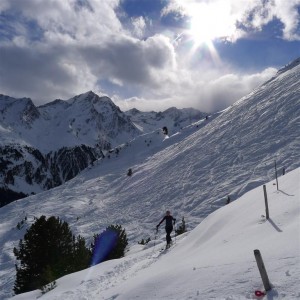
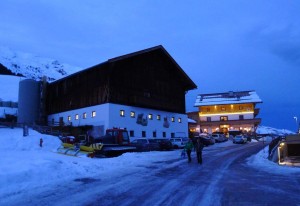
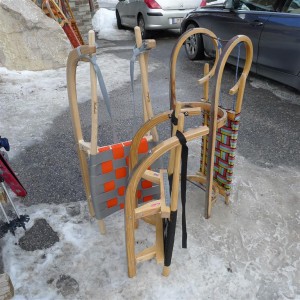
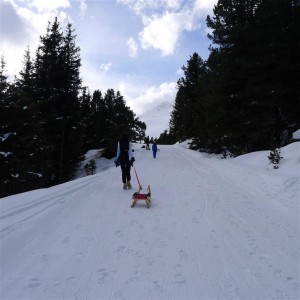
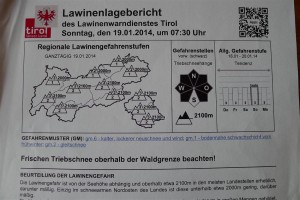
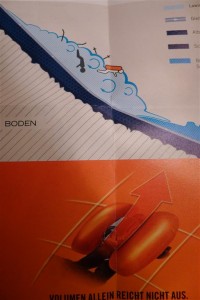
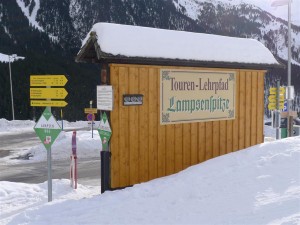
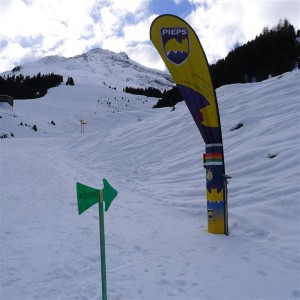
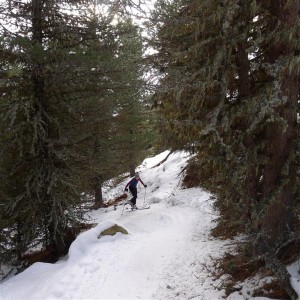
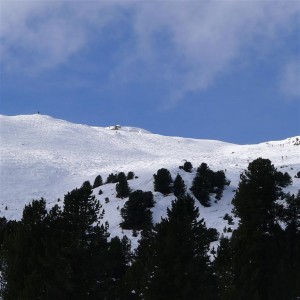
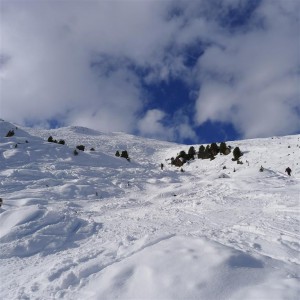
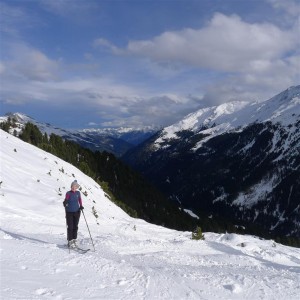
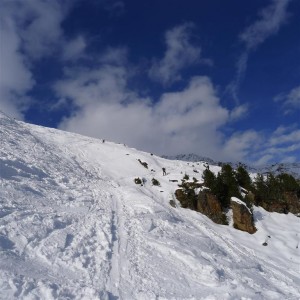
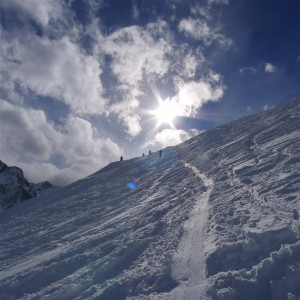
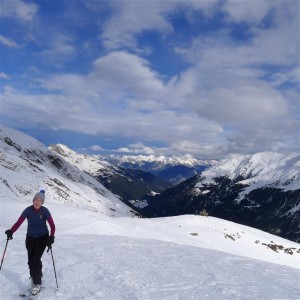

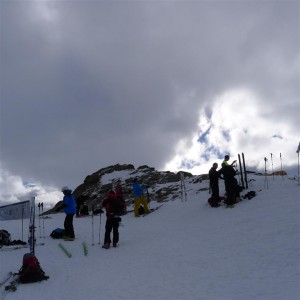
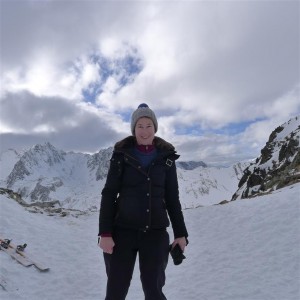
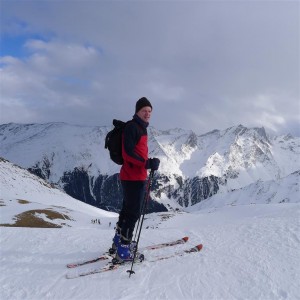
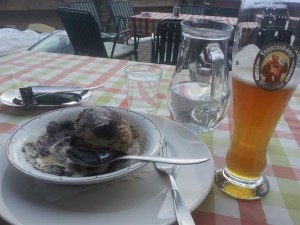
And to think that we get tired walking up High Street in Walpole! Thanks for another great adventure.
oh WOW the views! Thanks for sharing, fun to read 🙂